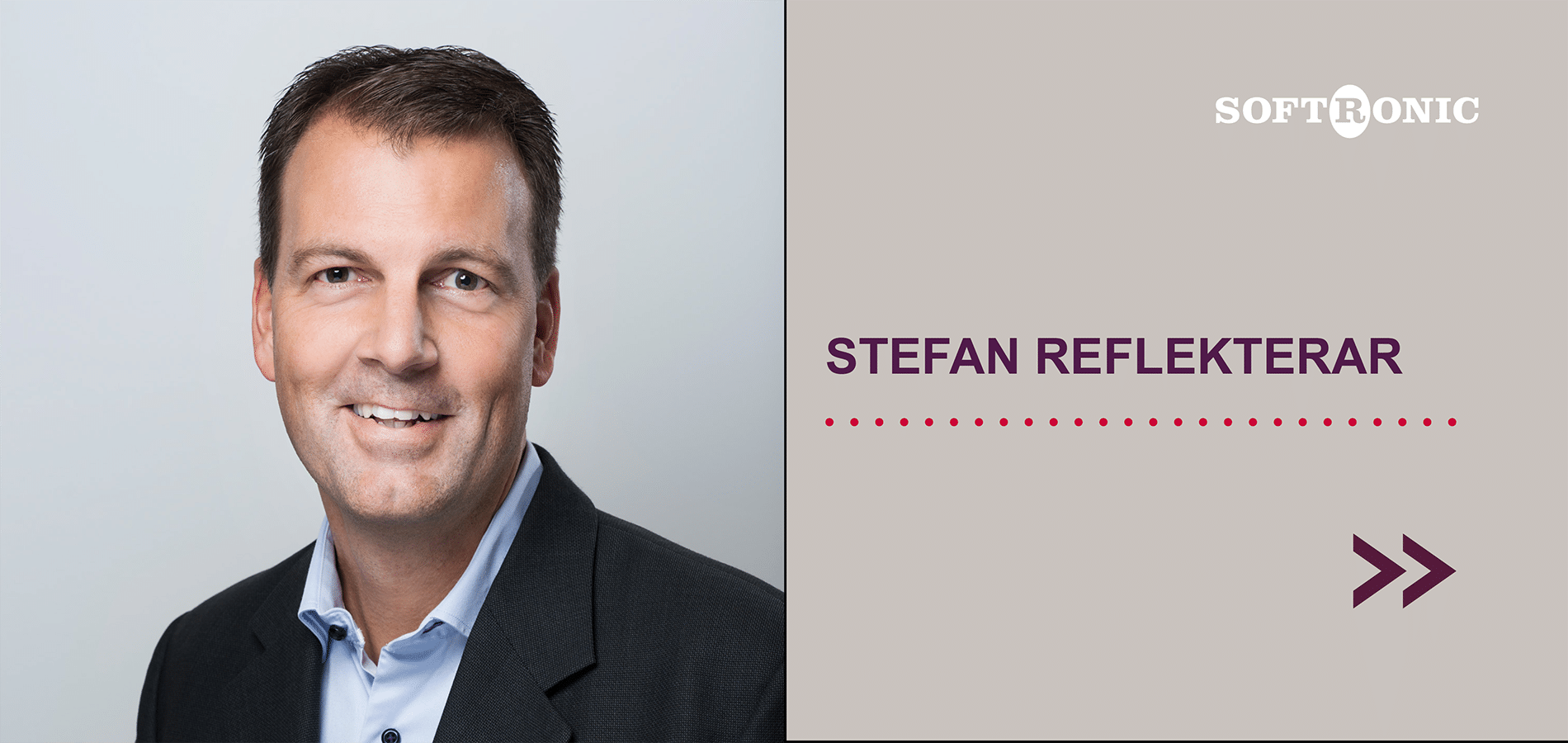
AI, IoT and handling masses of data. Are you keeping up with all the new concepts or are you starting to feel stressed? If you are, then maybe you should think like Winnie the Pooh: “Rivers know this; there is no hurry. We shall get there some day.”
In ‘Stefan reflects’, you find out Stefan Palm’s thoughts on new technology and how to benefit from it to create value in organisations and companies.
My passion is to help organisations and individuals bridge the competence gap between what is actually possible with new technologies and the perceived value of new technology. Many organisations have their hands full trying to run their business, while facing a high rate of innovation and often with fewer resources. So it can be a challenge to be able to work continually on a strategy and convey a vision and goals that everyone in the organisation can take on board. Unfortunately it is not that easy with the current range of technologies and solutions to ask someone (possibly a consultant) to ‘just’ explain what to do to benefit from all the new solutions marketed by the suppliers.
This is where I come into the picture, helping an organisation to benefit from new technology to meet a challenge. You should note that a challenge could be:
– something we do, but we could do better
– something that we don’t do, but we could benefit from it if we did.
However, sometimes the starting point could purely be a technical interest, for example, what we can do with AI. I personally have an extremely pragmatic relationship with technology. There are advantages and disadvantages of all kinds of solutions. The idea is simply to understand the frameworks where each solution could add great value for you. My definition of value is for the total cost of the solution to be lower than the cost of the challenge (it is absolutely fine to stop here and read that sentence again).
Every organisation is different, so it is impossible to say what would be good or bad in advance. General solutions can be a good way of simply getting started, but you are often looking for specific values when evaluating new technologies. However, when you are doing something for the first time, it can feel like a real challenge. How do you start evaluating the benefit of AI?
And this is when you need to listen to Winnie the Pooh. If you are going to make a change, you want to know that you are going in a direction that brings you closer to the goal. If you do not have a vision or goals, it is extremely difficult to assess whether new technology adds anything to your organisation, or if it just distracts your operations from what is actually important. So although the dialogue starts by discussing new, exciting technology, you should sometimes invest a little time and resources in defining a set of goals in the form of a general architecture. I want to make it clear that this set of goals/this architecture is not static; it is something that needs to be worked on constantly and updated following any changes to the operations or when new technologies and solutions become available.
When I am evaluating new technologies, I collect knowledge and experiences that I will try to share in a way that inspires people and might also make them curious. I do not go into a lot of technical detail as there are other people who focus on this. Instead I give my thoughts and reflections on what the benefit is, and what you should maybe think a little extra about when evaluating new technologies.
In this post, I want to reflect on some of the ‘big pieces of the puzzle’ and define the areas that many people are talking about. I will look a bit more deeply into each area.
New technologies: AI and IOT
Let’s start with Artificial Intelligence (AI). This acronym is used more than ‘Digital Transformation’ was before. There are so many people who mean Machine Learning (ML), when they are talking about AI. And so many people who say that they have AI solutions when they are actually only using advanced analysis functions. There is so much potential to gain from new services that are being developed and sold under the concept of ‘AI’. It can be extremely easy to start testing, but sometimes frustratingly difficult to deliver something that the operations can actually benefit from. To quote a major global organisation: “We have more pilots in our organisation than Lufthansa.”
When you are talking about AI, you inevitably find yourself in the area of ‘data’, normally in large volumes, i.e. Big Data. Managing large volumes is a challenge in itself, but is actually not what the focus is. The opportunity to start to gain insights from unstructured data is what is attractive. Although it is true that today’s solutions are often based on a structured database, there is a large amount of data outside this structured database. There are solutions available from many suppliers that provide organisations with the ability to gain insights from documents, speech/sound or images/video.
However, sometimes you need to collect even more information and at the moment it is neither difficult nor expensive to link one ‘thing’ using the Internet of Things (IoT) solutions. This is an area where technology offers masses of opportunities, but you may need to spend a little time on processes. Building something that works is one thing, but the ability to support this solution for ten years (or however long it is expected to be in place) is something that few organisations can do. And this is where the financial aspect comes in, as we have to calculate the value of this solution during the lifetime of the ‘thing’ (using the definition of value above, if you remember).
There is a risk of handling IoT as infrastructure and only seeing it as a cost. You forget the great value generated from the data that the IoT solution delivers to the organisation. Of course you should evaluate whether this information could be obtained in a different way than building your own solution. The supply of purchased data is a market that is growing rapidly and many new partnerships are being formed to share the costs of collecting data and maybe also sharing revenues from the new services that are powered by this data.
When you are building new services today, it is data that is really the fuel that is powering the solution. Event-driven services built using micro-services, where the developers receive direct feedback on how users perceive the service. At the moment it is easy to just think of ‘apps’ (which often include modern web services), but now your service can be shown as an API. With both options the value only arises when someone is using the services, so the insights into this use are what results in the continual work to optimise the service over time.
In my opinion what is often referred to as ‘management’ should actually be called ‘optimisation’. During the lifetime of the solution you need to work constantly on the availability, performance, costs, security and underlying technologies. Doing nothing is not an option. The world around us is changing so quickly and the users do not normally have to look far to find an alternative solution.
Contact
Follow me on a journey now through new technologies and solutions, insights and opinions, facts and thoughts. And of course you are more than welcome to contact me if you have feedback on anything I am writing or if there is anything you would like me to discuss by sending an email to stefan.palm@softronic.se
Or search for me on LinkedIn, where I share a wide variety of thoughts about life in general.
Related links:
Blog post written by Stefan Palm – copyright Softronic.

